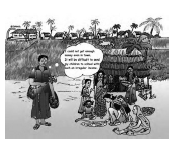To download the complete Syllabus (PDF File), Please fill & submit the form below.
Q. When was Mahatma Gandhi National Rural Employment Guarantee Act initiated?
- (a) 2005
- (b) 2000
- (c) 1990
- (d) 1993
- Ans. (a) 2005
Q. Study the picture and answer the question that follows:

Which of the following aspects best signifies this image?
- (a) Poverty
- (b) Population
- (c) Illiteracy
- (d) All of the above
- Ans. (a) Poverty
Q. Which of the following options best signifies the picture?

- (a) Landless labour
- (b) Big farmer
- (c) Urban area
- (d) None of the above
- Ans. (a) Landless labour
Q. What does this picture show?

- (a) Poverty line
- (b) Poverty
- (c) Social exclusion
- (d) None of these
- Ans. (c) Social exclusion
Q. In India, percentage of poverty in urban areas is ___________ than poverty in rural areas.
Ans. lesser
Q. With the spread of irrigation and the Green Revolution, ____________.
Ans. Many job opportunities were created in the agriculture sector.
Q. Every second person in India lives in poverty.
Ans. False
Q. Every second person in India lives in poverty.
Ans. False
Q. Name one of the most important and difficult challenges faced by independent India?
Ans. Poverty is one of the most important and difficult challenges faced by independent India.
Q. What did Mahatma Gandhi say about poverty?
Ans. Mahatma Gandhi always said that India would be truly independent only when the poorest of its people become free of human suffering.
Q. What are the different dimensions of poverty? What is poverty?
Ans. Hunger and a lack of shelter are two aspects of poverty. Parents who are unable to send their children to school are in this circumstance. It is a condition in which sick people are unable to pay for medical treatment. Poverty also means a lack of access to safe drinking water and sanitation. It also suggests that you don't have a job that pays at least well to fulfill your basic necessities. It also entails a feeling of powerlessness.
Q. What were the aims of Swarnajayanti Gram Swarozgar Yojana? In which year it was launched?
Ans. The aims of this scheme were to bring the assisted poor families above the poverty line by organising them into self help groups through a mix of bank credit and government subsidy.
The scheme was launched in 1999.
Q. Explain colonial rule and income inequalities as causes of poverty.
Ans. One of the historical reasons for poverty is the low level of economic development under the British colonial administration. The policies of the colonial government ruined traditional handicrafts and discouraged development of industries like textiles.
Income inequalities have resulted from non-availability of land to rural landless labourers. Thus, they are forced to work for low wages for the large farmers, leading to poverty as they are not able to meet their daily needs with their meagre earnings.
Q. Describe the contribution of Green Revolution to eradicate the poverty in India.
Ans. Green Revolution has increased the production and productivity of agriculture, mostly in West and North- West. It enhanced food security and also created many job opportunities in agriculture. It has helped to reduce poverty in certain parts of India. But as the effects are limited to some parts, so in other regions, there are still significant number of poor people.
Q. Describe how the poverty is seen by social scientists.
Ans. Social scientists use the following indicators to examine poverty.
- (i) Level of illiteracy: Parents who are unable to send their children to school are in this circumstance.
- (ii) Inadequate healthcare access: This is a circumstance in which sick people are unable to pay for treatment.
- (iii) Inadequate drinking water access: This refers to a lack of safe and clean drinking water facilities.
- (iv) Job insecurity: This refers to the absence of a regular job opportunity.
- (v) Lack of general resistance: It refers to an overall lack of resistance caused by starvation.
- (vi) Lack of sanitation: This refers to the need to clean up our surroundings.
Q. What is poverty line? What are the calories and rupees fixed for rural and urban areas for measuring the poverty line?
Ans. Poverty Line: It is an imaginary line used by any country to determine its poverty.
Calories and Rupees fixed for rural and urban areas to measure poverty line: The poverty line fixed for the rural and urban areas in India according to the year 2012 was ₹816 and ₹1000 per person per month, respectively. It is higher in urban areas because of high prices of many essential commodities in urban areas. The accepted average of calories requirement in India is 2400 calories per person per day in rural areas and 2100 calories in urban areas. It is high in the rural areas because of more physical work done by the rural people.
Q. Assertion (A): World Bank is important in estimating poverty line.
Reason (R): The World Bank compares countries by presenting a uniform standard for poverty line which is acceptable by all countries.
Ans. (a) Both A and R are true and R is the correct explanation of A.
According to the current degree of development, different countries have varying poverty lines and accept diverse social norms. The World Bank compares all countries and, presenting a uniform standard for the poverty line, all countries accept this.

